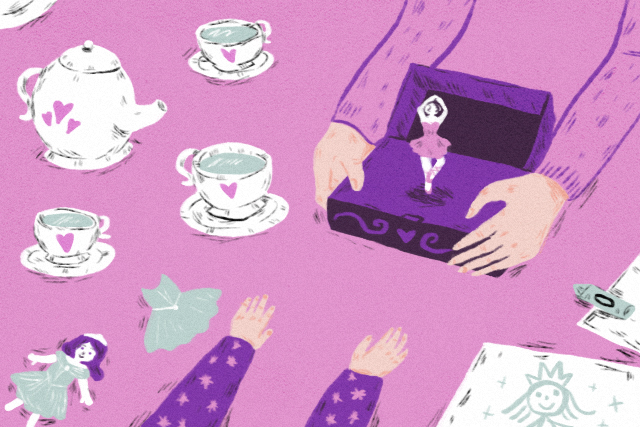
Every week, Preen tackles motherhood sans the rose-tinted glasses. Our columnists L. Juliano, Marla Darwin, Monica Eleazar-Manzano, Rossana Unson, Ronna Capili-Bonifacio, and Chrina Cuna-Henson tell their personal experiences like it is—at times frustrating, oftentimes confusing, but always enlightening.
Valuing a child’s autonomy means a lot to my parenting. It’s very important to me to value her consent and to respect her choices, all within reason.
When she was a baby, I was very big on going gender neutral for her to feel free to choose however she wanted to express herself.
Then I found myself wavering all the time, choosing delicate pastels and ruffles to accompany traditional feminine physical traits I saw in her, like her doll-like curls, rosy cheeks, and long eyelashes. When I started feeling guilty for my choices, I reminded myself that she will start making her opinions felt soon enough and I will make sure to accommodate them.
And I’ll admit, I was ready to act out of my ideals in case my kid wanted to get a Mohawk hairstyle or wear briefs. There was a bizarre thrill I got out of the idea of being my kid’s number one advocate as we challenged norms together.
Alas, what I ended up with is a total girly girl who loves tutus, makeup, and princesses.
Which would’ve been fine if not for the massive discomfort girly girls give me. I had to be true to my promise of child autonomy. My daughter went for the land of pretty pink tea parties all on her own and I am to honor her choices.
It’s not so hard. The princesses of her generation have gone a long way since the ones from my time. When you ask her what a princess does, she’ll say that they sing, dance, twirl… then her eyes will take on a determined look and tell you that they fire arrows, wield swords, ride horses, and rescue their parents. There is a ton of incredible representation for little girls in the world right now and it’s an exciting time.

The problem isn’t her, it’s me. When I follow the trail of my discomfort, I am led to a lot of internalized prejudices that I haven’t completely shaken off.
What I thought would be a trail ends up as one big tangled web. There must be a point in my childhood where I believed imbibing masculine traits (but not too much) was good, and too much feminine was bad because kerengkeng.
Kerengkeng is one of those words I was taught never to embody. I’m still not sure what it translates to but I learned it as “flirty”––using feminine traits to attract male attention. Combine it with how I was raised to fear sexuality, kerengkeng was one of the ultimate taboos.
At home and at school, the messaging I got was that to flirt is to sin. Before I knew anything about sex, I was cautioned not to catch the attention of boys. I had a primitive notion of sex appeal so equated flirting with wearing skimpy clothes, using makeup, or wearing high heels. So as long as I didn’t participate heavily in the rituals of girlhood, I won’t be classified as a flirt.
It was a weird conjecture, for sure, considering I was a big teenage flirt hiding in baggy pants and combat boots.
The other ways the feminine were introduced to me also dampened whatever inclination I had towards it. I grew up in a conservative religious environment so the image of femininity presented to me involved a mastery of domestic arts, acquiescence, and passivity––things valued in their ideals of womanhood as wifehood, but things I didn’t possess. I had this image of the feminine that was so detached from me that I ended up detaching from it.
Even as I’m doing the work to reclaim my womanhood, I still struggle with the stereotypes I formed in my head. Girly girls are dumb. Girly girls are boy crazy. Girly girls are superficial. When I started distilling my formative beliefs, they all lead me to sex. The abhorrence of kerengkeng was a disdain of sexuality as a currency. The ideal of wifehood is rooted in child bearing and rearing as currency.
And whether I was aware of it or not, my discomfort with girly girls is traced to me sexualizing girlhood.
I would like to make my apologies to girlhood and all the women I’ve placed in a pretty pink tea party box.
This doesn’t mean though that I won’t be having conversations about the aforementioned currencies, it’s just that my daughter and I will enjoy liking what we like while we do it—tutus, combat boots, and all.
Disclaimer: The views expressed here are solely those of the author in her private capacity and do not in any way represent the views of Preen.ph, or any other entity of the Inquirer Group of Companies.
Art by Marian Hukom
For the latest in culture, fashion, beauty, and celebrities, subscribe to our weekly newsletter here
Follow Preen on Facebook, Instagram, Twitter, YouTube, and Viber
Related stories:
Why I’m teaching my daughter marriage is not for everyone
This is how Stephen Curry fights gender inequality for his daughters
Why I choose E.Q. over I.Q. when raising my child
Dealing with ‘mom-guilt’ and learning to do what’s best


